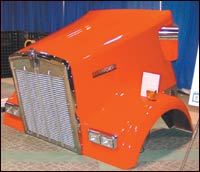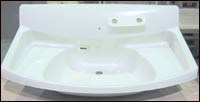Poly-DCPD RIM Shifts into Higher Gear
Heavy trucks and farm tractors are giving increased visibility to a RIM material that attracted little publicity for more than a decade.
Heavy trucks and farm tractors are giving increased visibility to a RIM material that attracted little publicity for more than a decade. During this time, poly-dicyclopentadiene (P-DCPD) graduated from unglamorous industrial applications to heavy-vehicle exterior components as an alternative to fiberglass/polyester composites and aluminum. The big breakthrough in the heavy truck arena came in 1996 with the Kenworth T2000 18-wheeler, which had 14 exterior components of P-DCPD varying in size from an 80-lb roof fairing to smaller parts of 10 to 15 lb each.
Within the last year, P-DCPD RIM made its mark in the hood—the most critical appearance part—of Class 8 heavy trucks. The first P-DCPD hood appeared last year on the model 9900 from Navistar’s International Truck and Engine Corp. in Warrenville, Ill. Currently, the most prestigious application for P-DCPD is the hood on the new top-of-the-line W900L model from Kenworth Truck Co., Kirkland, Wash. Molded of Metton LMR (liquid molding resin) from Metton America, the hood went into production in March.
According to Scott Weatherford, project engineer at Kenworth Truck, P-DCPD replaced a spray-up FRP composite at no additional cost and with an 84-lb weight saving. Although P-DCPD has a lower tensile modulus than FRP, it is more flexible and better resists impact damage, he notes.
P-DCPD RIM is used on fewer than 10% of heavy trucks, but that share is likely to grow. A lightly crosslinked olefinic thermoset, P-DCPD has mechanical properties similar to engineering thermoplastics. Among its advantages are low viscosity (300 cp), which permits molding at low pressure (15-30 psi) and easily fills complex parts. Also, holes can be molded directly into the part without causing knit lines.
The RIM process lends itself to greater automation and lower labor costs than FRP spray-up, RTM, or SMC. P-DCPD RIM also uses much lower-cost tools than does SMC. For example, the Kenworth W900 hood was made in a nickel-shell cavity tool with a cast-aluminum core. The resin’s low specific gravity of 1.03 offers additional cost and weight savings.
Jim Brown, president of the leading molder of P-DCPD, Paramont Mfg. LLC of Abington, Va., says that as a rule, P-DCPD makes sense for production volumes ranging from 2000 to 30,000 parts/yr. He also sees the best fit in large parts weighing 20 to 150 lb.
Gaining glamour
In the U.S., there are two suppliers of P-DPCD RIM materials. One is Metton America, which bought the Metton business from Hercules, Inc. in 1995. The other resin family, called Telene, was originally developed by BFGoodrich, which formed a joint venture in 2000 with Advanced Polymer Technologies LLC (APT) of Huntsville, Texas. Now, the Telene business is operated by Cymetech LLC, which is jointly owned by APT and Sterling JA, LLC, a privately held investment firm. Materials based on Metton and Telene technologies are also available under various trade names in Europe and Japan.
Cymetech president Charles Woodson says that prior to the recent upsurge of interest by truck and tractor makers, the main application for Telene was corrosion-resistant covers for chlorine/caustic reactor cells. Those P-DCPD parts are 10 ft long, 4 ft wide, and 3 ft high and weigh from 500 to 1000 lb. Another industrial application has been small, unreinforced pipe. “Newer uses are exterior parts with Class-A finish for tractors and tonneau covers for pick-up trucks. All are big parts ranging up to 8-10 ft long and 100-125 lb or more,” Woodson says.
There are estimated to be no more than 10 molders of P-DCPD in the U.S. and 15-20 each in Europe and Japan. Devoted exclusively to P-DCPD, Paramont has over 12 years of experience with the material. Paramont operates 16 RIM presses that can mold parts as large as 12 x 12 ft. The company’s initial foray into P-DCPD in the early ’90s was for molding 275- and 355-gal containers for hazardous waste.
Since 1995, Paramont’s focus has been on parts for large trucks, which account for 80% of its business. Says Brown, “We are providing P-DCPD parts to major OEMs—International, Kenworth, Volvo, Mack, Peterbilt, and Freightliner. Our parts make up all outer-skin components except for the cab.” They include side-chassis and roof fairings, vertical extenders, sun visors, bumpers, lower bumper air dams, and now hoods. Paramont molds both the International 9900 and Kenworth W900L hoods. These parts can total 300 to 500 lb of P-DCPD per truck: A hood weighs about 120 to 158 lb; a bumper, 35 lb; fairings, 17 lb each; side extenders, 10 to 15 lb apiece; sun visor, 10 to 15 lb; and roof fairing, 60-80 lb.
Paramont’s other 20% of its business is hoods, fenders, and door skins for agricultural and construction vehicles, as well as large electronic cabinets measuring around 10 cu ft.
GI Plastek of Westlake, Ohio, whose major focus is on agricultural and construction vehicles, has about three years of P-DCPD RIM experience and is looking to get more. This is evident at the company’s new plant in DeWitt, Iowa, which is equipped with two P-DCPD RIM presses. Says Steve Ettore, new-business development manager, “P-DCPD is attractive where you need a better impact/stiffness balance and higher HDT for parts such as fenders and hoods of backhoes or wheel loaders. It is replacing metal, primarily, and SMC to a lesser degree.”
P-DCPD RIM applications for GI Plastek include fenders for John Deere farm tractors. Other applications include dunnage trays for carrying automotive engines, transmissions, and aftermarket parts. Arctic Cat and Polaris snowmobiles use some P-DCPD parts, too.
Other U.S. molders of P-DCPD include Global Glass, Elkhart, Ind., which has molded P-DCPD running boards for vans since 1990. Romeo RIM in Romeo, Mich., molds P-DCPD parts for agricultural-vehicle and heavy-truck exteriors. ReAct in Dayton, Ohio, focuses on industrial applications such as railroad chocks. Meridian Automotive Systems of Troy, Mich., recently started up its first P-DCPD RIM operation in Salisbury, N.C., to make parts for heavy trucks. Others with P-DCPD RIM industrial and truck molding experience include Osborne Industries, Osborne, Kan., and Q3 Allmand Industries, Livonia, Mich.
Rolf Niederhausen, managing director of LMC Technik Ltd., a major molder of Metton and Telene in the U.K., says the most exciting P-DCPD applications in Europe are parts for heavy vehicles from Volvo Truck, Caterpillar, and John Deere. He sees potential in large fittings for water pipes.
In Japan, most of the P-DCPD market has been for large (440-lb) water-treatment vessels as well as auto bumpers. According to Metton America v.p. Garland Lee, Nissan and Toyota use Metton P-DCPD to mold bumper fascias for brand-new car models when volumes are smaller and then switch to TPO as production volumes grow.
Pluses and minuses
Although P-DCPD RIM does not match the performance of FRP or SMC in terms of all mechanical and thermal properties, it does have a notched Izod impact of 8.7 ft-lb/in. and retains 2 ft-lb/in. at –40 F. It also has good chemical resistance.
The two liquid components of P-DCPD are mixed at a 1:1 ratio and injected into a heated, closed mold. Cycle times are typically 4 to 6 min. Injection time is about 10 to 20 sec, and cure time is about 1 to 2 min. Unlike most thermoplastics, P-DCPD can mold parts up to 12 in. thick. What’s more, Paramont molds 13 different lengths of Kenworth mid-chassis side fairings by placing inserts on the core side of the mold, thereby producing multiple product variations on the same tool.
P-DCPD has a relatively high coefficient of linear thermal expansion, which could lead to problems if it were mated with components made from other materials. Consequently, Kenworth designed all of the hood’s 10 structural components from P-DCPD.
An important element in P-DCPD’s success in truck exteriors is its ability to achieve Class A surface finish with little preparation before painting. In-mold coating (IMC) technology is currently being developed by GI Plastek and Cymetech. According to GI Plastek’s Ettore, the process entails injection of P-DCPD followed by the coating.
Cymetech has a new Telene P-DCPD formulation for in-mold coating. It also introduced a non-halogen flame-retardant Telene formulation. (Metton America has offered an FR formulation for several years. It is used to make medical-equipment housings.)
Objectionable odor caused by residual DCPD monomer in molded parts reportedly has been reduced dramatically. Says Lee, “We have tweaked the material to allow more complete polymerization.” He says the problem stemmed from the catalyst’s sensitivity to oxygen and moisture. “Molders have learned to make sure the material is kept in an inert environment as it goes from package to day tanks. They also purge molds with nitrogen to eliminate moisture on the surface.”
Cymetech is developing new versions of P-DCPD based on ruthenium catalysts in place of the usual molybdenum (Telene) or tungsten (Metton). The new catalysts allow longer pot life and are not sensitive to “poisoning” by additives and reinforcements. Cymetech is looking beyond RIM to RTM, low-pressure pouring, and centrifugal casting, as well foams and structural parts with glass and carbon fibers.
Says Woodson, “With ruthenium catalysts, we can get much higher tensile strength, impact, or HDT—up to 200 C (392 F) vs. the current 120-130 C (248-266 F).” Commercial use of ruthenium has begun in Japan with shower stalls and basins. Cymetech expects to commercialize the technology in the U.S. next year. —Lilli Manolis Sherman
Read Next
Why (and What) You Need to Dry
Other than polyolefins, almost every other polymer exhibits some level of polarity and therefore can absorb a certain amount of moisture from the atmosphere. Here’s a look at some of these materials, and what needs to be done to dry them.
Read MoreAdvanced Recycling: Beyond Pyrolysis
Consumer-product brand owners increasingly see advanced chemical recycling as a necessary complement to mechanical recycling if they are to meet ambitious goals for a circular economy in the next decade. Dozens of technology providers are developing new technologies to overcome the limitations of existing pyrolysis methods and to commercialize various alternative approaches to chemical recycling of plastics.
Read More

















.png;maxWidth=300;quality=90)








